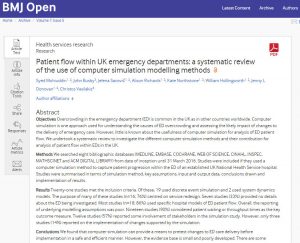Patient flow in UK emergency departments: a systematic review of computer simulation modelling
Overcrowding in emergency departments (ED) is a growing problem. It’s bad for patients, leading to longer waiting times, more medical errors, poor care and patient outcomes. It increases staff workload, leading to frustration and poor morale. This can mean some patients leave without being seen by a doctor, only to return later with a more complicated condition.
The Department of Health and Social Care target for NHS acute hospitals is that at least 95 per cent of patients attending an emergency department must be seen, treated, admitted or discharged in less than four hours.
Improving patient flow through ED could be key to reducing overcrowding, and studies using computer simulations have explored this. But we don’t know which computer simulation methods are best when looking at the delivery of emergency care, so we did a systematic review of the existing research.
Project aims
We aimed to:
- investigate how computer simulation studies contribute to the understanding of ED overcrowding
- identify which methods have been used for patient flow simulation
- assess how useful each method is for service redesign and evaluate its impact on delivery of emergency care
- report on how different simulation methods affected ED performance
- identify studies that aimed to meet the needs of stakeholders
What we did
We searched for studies published up to 31 March 2016 that used a computer simulation method to capture patient progress through NHS emergency departments. We looked at the studies’:
- simulation methods
- key assumptions
- input and output data
- conclusions
- implementation of results
What we found and what this means
We found 21 studies that met our criteria. Of these, 19 used discrete event simulation and two used system dynamics models.
The purpose of many of these studies (n=16; 76 per cent) was service redesign. Seven studies (33 per cent) provided no details about the ED they were investigating. Most studies (n=18; 86 per cent) used specific hospital models of ED patient flow.
Overall, the reporting of underlying modelling assumptions was poor. Nineteen studies (90 per cent) considered patient waiting or throughput times as the key outcome measure. Twelve studies (57 per cent) reported some involvement of stakeholders in the simulation study. However, only three studies (14 per cent) reported on the implementation of changes supported by the simulation.
We found that computer simulation can be a safe and efficient means to pre-test the likely impact of changes to the delivery of emergency care before implementation. It was particularly used to:
- identify the key relationships and bottlenecks in the process of ED care
- test ‘what-if’ scenarios for service redesign
- determine levels of uncertainty
- provide visualisations
- forecast future performance
But overall the evidence base is small and poorly developed, with many methodological and practical issues, including a lack of:
- awareness regarding system complexity
- good quality data
- persistent engagement of stakeholders in the modelling process
- in-house analytical skills
- an implementation plan.
What next?
This review offers direction on how simulation can be better used as a tool for analysing ED patient flow. Future studies should:
- explicitly justify the choice of simulation modelling method
- avoid making selective use of the available data
- engage stakeholders in the modelling process and keep them on board throughout
- be transparent when reporting simulation inputs and outputs
- report on the implementation of changes supported by the findings of simulation experiments
We recommend that academic journals and conference proceedings adopt reporting guidelines for this kind of research. Innovative models of engagement and knowledge mobilisation between academics and healthcare professionals, such as Researchers in Residence, should be exploited more consistently.
More research is needed to assess the quality of computer simulation models of ED patient flow in different countries and to understand how far the results of simulations have been translated into policy.
Paper
